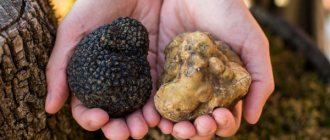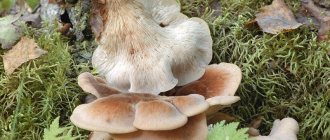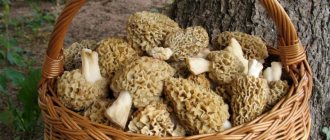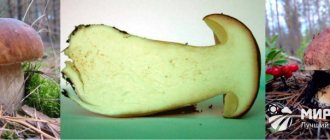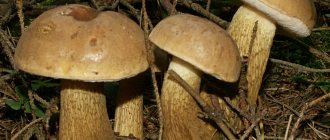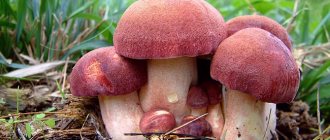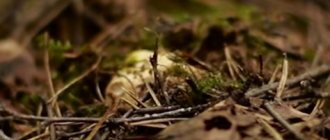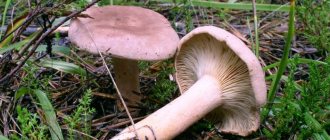The value of truffles lies in their unusual taste and aroma, which is why these mushrooms are considered a delicacy, and their cost on the market can reach several thousand dollars. Photos and descriptions of truffles will help you find them in the forest yourself.
Read today's article for a description and photo of the truffle mushroom, where it grows and how to look for it correctly.
- Main differences from other mushrooms
- Peculiarities
- Peculiarities
Description of false truffles
The main distinctive feature of false truffles is the fact that the edible delicacy belongs to the Truffle family, class Pezizomycetes, and inedible counterparts are not included in this family. Edible mushrooms include such representatives as Black truffles (winter, Perigord, autumn Burgundy, Russian, etc.), White Piedmontese and a host of other varieties.
There are many types and false truffles. One of the most common is Melanogaster broomeanus, also known as the Truffle Grebe. It has absolutely nothing to do with the noble Truffle family, although it looks similar to its edible counterparts. Belongs to the Svinukhovs. Named after the 19th century English mycologist Broome.
It has a spherical tuber, 1–8 cm in diameter. There are mycelia with an irregularly shaped mushroom body. They have this interesting feature: they compress quite easily and also restore their shape well if the pressure is released. Externally, a young mushroom looks like a potato: a light tuber of cream or yellow color, which darkens with age. By old age it can become almost black. The peridium, the outer shell, most often has a smooth texture, although it can also have a mesh texture, reminiscent of a ripe melon.
Inside, the mushroom has a jelly-like, although rather elastic, consistency . At first the gleba (pulp) is beige, maybe creamy, then it darkens, becoming almost black with age. We can say that the fruiting body of the mushroom resembles a sponge. Truffle toadstool can be identified by its pleasant fruity smell, which sometimes misleads mushroom pickers.
Reindeer truffle
Another variety of false truffles is the Deer truffle, also known as Pargu, Parushka or Elaphomyces granulosa. It has a fruiting body (cleistothecia) 1–4 cm in diameter. Color ranges from white (in youth) to almost black with age.
It lies at a depth of 2–14 cm. It has a strong characteristic odor, similar to that of potatoes during harvesting (the smell of black soil, humus). Pargu's closest relatives are the spiny truffle and the red-brown truffle, although they are less common.
Growing and care at home and in the country
Many people are interested in the question: is it possible to cultivate truffles independently, what are the rules and conditions for growing this mushroom? Under natural conditions, fat mushrooms spread with the help of forest dwellers who eat grown mushrooms.
Truffle spores fall to the roots of trees along with animal feces and form a symbiosis with them. In some European countries, as well as in China, the production of truffles in an artificial environment has long been practiced.
Factors necessary for successful truffle breeding:
- favorable weather conditions;
- appropriate soil;
- trees with which truffles form mycorrhizae.
How to grow truffles at home, in the garden or at your dacha:
- Infect hazel growths with mycelium.
- After germination, place the hazel in sterile conditions and wait 2 weeks until the mycelium grows and takes root in the oak roots.
- After the seedlings are infected, the cultivation of seedlings continues in the winter in a quarantined nursery.
- In a year, the mycelium will fully develop and the substrate will be infected with mycelium. The shoots can grow up to 20 cm.
Carrying out further care:
- it is necessary to apply NPK fertilizers;
- destroy weeds with herbicides;
- Sprinkle the seedlings with soil and water them.
Edibility
With good reason, false truffles cannot be called poisonous, although they are unsuitable for human consumption. But deer, rodents, wild boars and other mammals eat them with pleasure.
Although it is not difficult to confuse edible and inedible mushrooms, you should not be too afraid of making a mistake. As already mentioned, false truffle is not poisonous, but it has an unpleasant taste and can cause food poisoning. However, for poisoning you need to eat a considerable amount of mushrooms, which is extremely difficult to do unintentionally due to their taste.
Application in cosmetology and medicine
Truffle extract is used in cosmetology only after consultation with the attending physician - this mushroom is considered a very strong allergen.
Mushrooms are used in cosmetology
It is added to masks for hair, face, skin and nails for the purpose of:
- preventing age-related changes;
- smoothing the skin of the face and body;
- reducing the degree of hyperpigmentation and whitening;
- tightening and moisturizing the skin;
- accelerating hair and nail growth.
White truffles have strong antiviral properties; many eye diseases are treated with mushroom juice. For gout, frequent consumption of these mushrooms leads to remission or complete cure.
Tinctures help with general weakening of the body, erectile dysfunction, and diarrhea.
Where do truffle-like mushrooms grow?
The Deer Truffle is the most common member of the genus Elaphomyces. In addition, this mushroom is the most popular representative among all the mushrooms growing underground in the Northern Hemisphere. In addition, there is information that parga was found in South America, China, Japan, and some other regions of Southeast Asia.
Habitat: from the polar regions of the Arctic to the subtropical zone.
In the territory of the post-Soviet space, there are a lot of false truffles in the Novosibirsk region of Russia, in Kazakhstan. Most often found in deciduous forests with a pH of 6.0 and below. In coniferous forests, with the exception of the Novosibirsk region, it is much less common.
White Truffle Festival in Alba
The opening of the festival usually takes place on the first Saturday of October. At the event you will be able to purchase a pair of luxury mushrooms for about 10 euros each. Only during the festival, local residents give everyone excursions to the places where truffles grow, during which you can eat the mushrooms raw straight from the clearing.
At this time, closed auctions are held for chefs of the best restaurants in Italy, who are offered to buy truffles at a price of 3 thousand dollars per kilogram. Trading in tents, a carnival, donkey races, the winner of which receives a kilogram of treasured mushrooms as a gift, and much more can be seen in Alba during the white truffle festival.
Video reviews
A selection of videos with descriptions and recipes for preparing mushrooms
My Planet, Mushroom Hunter, Kuban 24
How to look for truffles
In addition to the differences mentioned above, there is another characteristic sign of how to distinguish a real delicacy from imitators. You can tell if a mushroom is edible by its depth: a real truffle can be found no closer than 50–70 cm from the surface of the earth, while false varieties grow no deeper than 15 cm.
The truffle harvesting season is quite short - black varieties are harvested from late autumn to early spring. The period for collecting white representatives of the species is even shorter - it begins around November and until the end of the year, that is, a little more than a month. Specially trained dogs or pigs are used for collection, otherwise this mushroom cannot be found. In Russia it is found on the Black Sea coast of the Caucasus, in the middle zone of the European part, in the Moscow region. Black truffle grows best in calcareous soils.
What are the prices for 1 kg in Russia
Since the product has a short shelf life, you can only try it fresh during the harvest season. The delicacy cannot be found in supermarkets, but is sold in online gourmet food stores and catering establishments. Gastronomic markets purchase elite mushrooms in small quantities weighing 100 g, which are delivered from their growing places in special containers.
| Name | price, rub. |
| Fresh black truffle (Serbia), 1 kg | 55000 |
| Fresh frozen black truffle (Russia), 1 kg | 35000 |
| White truffle oil Urbani (Italy), 500 ml | 3 168 |
| Cream Calugi of champignons with white truffle (Italy), 500 g | 2 147 |
| Tartufi sauce with mushrooms and black truffle (Italy), 180 g | 1 081 |
When traveling through Italy in late autumn, you can taste fresh truffles in Piedmont restaurants. There, for about 180 euros, a menu is offered, the dishes of which will give the opportunity to fully appreciate the exclusivity of the mushroom. In addition, tourists are offered a truffle program, which includes a night hunt for the delicacy with a subsequent opportunity to buy it back.
Truffle mushroom: description and features of a rare delicacy
Truffle dishes are very expensive and the mushrooms themselves are considered an exquisite delicacy, since this species is quite rare, grows differently than the ones we are used to, is collected with the help of animals and has a very specific taste. Most mushroom pickers believe that these unusual fruits do not grow in Russia, but this is not so. Knowing what they look like, they can easily be found in our latitudes.
Useful properties and restrictions on use
Not many mushrooms have such a range of beneficial properties as truffles. All this is due to their rich composition: vegetable proteins, carbohydrates, vitamins B, PP and C, various minerals, antioxidants and fiber.
The juice of these mushrooms can help cure many eye diseases. The pulp will significantly relieve the symptoms of gout.
Eating them will help improve your emotional state not only due to their taste, but also to their composition. It is also used in cosmetology, since truffle-based cream can tighten the skin and eliminate wrinkles or age spots.
The calorie content of 100 g of truffle is 25 kcal
You may be interested in: How do edible talkers differ from false mushrooms? How many days after rain do mushrooms grow? Bitter mushroom: photo and detailed description
Doctors do not identify any special contraindications for eating fruits. The main thing is that the product is fresh, properly processed and the person simply does not have an allergy to penicillin.
Truffle is the most expensive and valuable mushroom in the world, and prices for dishes made from it sometimes reach thousands of dollars. All this is associated with small harvests, although nowadays it is also grown at home. However, this is a very long process, and the aroma of wild and domestic mushrooms will still be different. In addition, the difficulty of searching also increases the value of this product.
Description of truffles
The name of the mushroom is originally translated as “earth cone,” which is quite logical if you look at its external shape.
Structure and features of the species
Typically, fruiting bodies are either round or tuberous in shape. Some experts note that in appearance they look like potatoes. In addition, depending on the maturity of the tubers, they can be of different consistencies (dense or loose). Traditionally, the size is small (slightly larger than a walnut), but sometimes some individual fruiting bodies reach quite impressive sizes and can weigh up to 1 kg.
Truffle is considered one of the most popular delicacies in the world.
The outer layer can be either smooth or rough, as if cut by many cracks, sometimes it seems that it is covered with warts. When cutting the fruit, you can see the marbled pulp. It consists of internal and external veins, which have different shades. The “insides” can be of different colors depending on the type: black or chocolate, white or gray.
Is the truffle edible or not?
Experts say that it is better to eat it either completely raw or with minimal heat treatment to preserve the taste and aroma. Because if it is stored for a long time, it can lose all its beneficial qualities and specific taste.
What does it taste like
Experts say that the aroma has both a slight smell of autumn forest and rotten leaves, as well as ripe fruit, and smells a little like chocolate. It tastes very much like hazelnut, with a light fruity or chocolate aftertaste.
Use in cooking
In most cuisines of the world, truffle acts as an additional element to the main dish. An average of 8 grams of mushrooms are used per serving.
In France and Italy, truffles are preserved in jars, like ordinary champignons. They are marinated in wine and then topped with Provençal oil.
White truffle oil is very popular among gourmets and is used to flavor pasta or spaghetti.
Primary processing
The truffles are thoroughly washed in cold water, then poached in wine and cleaned. Not everyone knows how long to cook mushrooms. The heat treatment of these fruiting bodies should not be too long; just keep them in a preheated oven for five minutes. In general, white truffles are best served raw. To do this, they are carefully cleaned and cut into very thin strips.
White truffle sauce
This truffle sauce is made with butter. It is stored for a long time and goes well with a wide variety of dishes (pasta, macaroni), giving food a unique taste and aroma.
Ingredients:
- butter - 250 g;
- truffle - 40 g;
- chopped green onions - 2 tbsp. l.;
- parsley - 1 tbsp. l.;
- dill greens - 1 tbsp. l.;
- Provencal herbs - 1 tsp;
- ground black pepper - to taste;
- salt - to taste.
How to prepare the dish step by step:
- Place the butter in a deep bowl and leave to soften.
- Grate washed, clean truffles on a fine grater.
- Wash the parsley, onion and dill, dry and chop very finely.
- Add truffles, herbs, dry herbs and pepper with salt to the softened butter.
- Stir until smooth and place on foil.
- Form a sausage, give it an even shape and place in the freezer for 30 minutes.
Drying
One of the best ways to prepare truffles for storage is drying. The dehydrated mushroom completely retains its taste and will become as good as new when soaked.
Rules for drying truffles:
- To prevent the mushrooms from becoming saturated with water, they should not be washed when preparing for drying, otherwise they may rot;
- the thickness of the slices should be no more than 5 mm;
- to prevent the slices from touching and rotting, they are strung on a thread or knitting needle;
- in humid weather, you can dry the mushrooms in the oven on a baking sheet;
- Prepared mushrooms should be stored in cotton bags.
Advice! To prevent drying mushrooms from attracting flies, cover the slices with gauze folded in half.
Marinated truffles
Truffles can be preserved by canning. The mushrooms will lose some of their taste, but not significantly. Marinated truffles can be used in many dishes.
Ingredients:
- truffles – 1 kg;
- salt – 1 tsp;
- homemade vinegar - 0.5 tbsp;
- red wine – 0.5 tbsp;
- spices to taste;
- vegetable oil – 50 ml.
Cooking method:
- Wash the truffles from the soil, sprinkle with salt and place in clay pots.
- Mix wine with vinegar and pour over mushrooms. Place the pots tightly covered with foil into a hot oven.
- When the heat subsides, leave them in a warm place for 24 hours, then place them back in the hot oven for a few hours. Repeat the process for 4 days, then open the pots, fill with water to the brim and stir.
- Pour the liquid into a saucepan and leave the truffles to drain on a sieve.
- When the mushrooms are dry, transfer them to a ceramic cup and pour boiled mushroom juice with added salt and spices. Leave the truffles to cool.
- Place the prepared mushrooms in jars, fill with brine, and add a small layer of oil on top. They should be recessed by 1-2 cm.
- Seal tightly and store in a cool place with dry air.
Attention! To better preserve the taste, truffles are boiled in white wine, and olive oil is added to the jars.
Where and how exactly does the fruit grow?
The peculiarity of these fruiting bodies is that they grow underground next to the roots of not all trees, but only those of oak, beech, hornbeam, linden and poplar at a depth of 5 to 30 cm, but usually somewhere around 20 cm. The most valuable are those that were found precisely near the oak tree. They grow in small groups, on average 7 pieces, but you can also find single fruits.
The truffle's fruiting body is located underground
Naturally, they are found in forest areas of deciduous trees, much less often mixed or coniferous trees. In general, the distribution area is quite wide: Europe, Asia, North Africa, the United States of America. The search process itself is very painstaking and complex.
In Russia
To the surprise of many, these rare mushrooms can be found quite often in Russia. In addition, different species are found.
In the Leningrad region and Moscow region
White or golden truffles are found in this region. Most often they choose clearings of mixed forests, which have a lot of sunlight. They are also found on the edges of oak forests and in birch groves.
In Crimea
Winter dominates here. Traditionally it is harvested from late autumn to early spring. Moreover, when they grow, they reach quite large sizes - up to 15 cm, and their weight reaches one kilogram.
In Ukraine
The black summer species can be found in deciduous and mixed forests of Ukraine, where it is collected from November to January-February. It is most widespread, if one can say so about a rare mushroom, in the Volyn, Chernigov and Sumy regions. But even here, searching for it will take quite a lot of time.
Types of underground mushroom
There are more than a hundred species of this unusual mushroom. But not all of them are equally valued, since they have different tastes and beneficial properties. We are only interested in those that are the most famous and most often used in cooking.
White
Very common in Russia. The shape is usually an irregular circle, the fruit has a whitish color, which over time changes to yellow-brown. On average, the size is from 5 to 8 cm, but sometimes the diameter can reach 15 cm. A typical fruit weighs 200-300 grams, and a large one weighs up to 500 grams.
White truffle
The interior has an elastic structure and a light color with veins. It tastes like seeds or nuts that have been well roasted. It is collected from July to November in deciduous and coniferous forests. Experts say that the later they are harvested, the more interesting their taste and smell will be.
Black
They are called black summer or Russian. Can be found under the roots of oak, pine or hazel in Europe or Russia. They bear fruit from June to early October. This fruiting body grows up to 10 cm in diameter and 400 grams in weight. Externally, the mushroom is blue-black in color and covered with warts.
Black summer truffle
Young fruits are softer, while mature ones are looser. They have a specific algae smell. The inside can be from white-yellow to brown-gray. Usually the black summer truffle is not very deep underground, sometimes quite on the surface.
Red
It grows in most cases in Europe in deciduous and coniferous forests; it is harvested from September to January. The fruits are small in size: up to 4 cm in diameter and 80 grams in weight. The inside has a dense consistency and is yellow-brown in color. The aroma is very specific with herbal-coconut notes. The top layer has a special red color. It is not very much appreciated in cooking.
Red type of truffle
There is also a type called shiny red. Its distribution area is very wide: virtually all European countries. It is collected for a short period of time: only from May to August. And the size is even smaller than the usual red one - 1-5 cm, and weighs up to 50 g. The consistency is quite soft and with a pink tint. It has a mushroom aroma with notes of red wine, pear and coconut.
Truffle-like mushrooms
Not very experienced specialists may confuse truffles with other fruiting bodies, which have certain similarities in appearance, but differ significantly in taste and aroma. In addition, they can even be poisonous to humans, so you need to be especially careful.
False truffle
Another name is Melanogaster Bruma. This is a fairly rare species and is inedible. Outwardly, it is very similar to a truffle, since it has a spherical shape with a yellow-brown color, which darkens greatly over time. The surface is smooth, without cracks or warts.
False species or Bruma's melanogaster
The flesh is also very dark in color with yellow or white veins. Medium size: from 2 to 8 cm. Has a fruity aroma. It can be found in deciduous forests, and it lies very shallow. Sometimes it is even found under a pile of fallen leaves.
Deer
This fruiting body grows in mixed or spruce forests, which already distinguishes it from a real truffle. The shape is a little similar: round, tuberous. Their surface is usually smooth and golden in color.
Reindeer truffle
The flesh of an unripe fruit will be white or cream-colored without any veins, and a ripe one will be dark gray. You need to be very careful as it is inedible.
Differences between inedible mushrooms and edible ones
In order not to confuse true honey mushrooms and false ones, you need to know what false honey mushrooms look like. For example, a gallerina called bordered is a little similar to it. It is quite toxic, almost the same as the pale toadstool.
Growing in the same places as real honey fungus, it can become an unnecessary “trophy” for a mushroom picker. However, if you look closely, you will see that her hat is completely monochromatic, shiny and very smooth. Therefore, despite the presence of a ring, it is difficult to confuse it with an edible mushroom.
Knowing what edible mushrooms look like, you can safely collect such mushrooms. Everything is simple with the autumn scent.
There is a ring on the stem, a darkish spot in the center of the cap, plus the presence of dark-colored scales. In addition, its smell is quite pleasant, in no way allowing it to be confused with poisonous pseudo-honeymoons.
Summer honey fungus is easier to confuse with galerina. But the presence of a light-colored tubercle on the top of the cap is a very noticeable distinguishing feature. It is no secret to experienced mushroom pickers that it absolutely “cannot tolerate” deciduous forests.
Its “recognized” places are marked by the presence of humus from trees belonging to coniferous species
That is why it is important for a novice mushroom picker to remember that when collecting summer honey mushrooms, you should not go into a forest where mixed coniferous and deciduous trees or pure coniferous trees grow.
If we are talking about collecting honey mushrooms in winter, then such mushrooms do not have a noticeable ring on the stem. Based on this feature, they are quite easily distinguished from the poisonous galerina. However, they are very similar to false species. To recognize it you need to have some experience.
It is quite obvious that in the cold season, especially in the spring, honey fungus, called winter, is a mushroom that can be found in the singular in the forest zone.
What false truffle mushrooms look like
It is a spherical tuber with a diameter of 1 to 8 cm. “Tubers” of irregular shape are often found. Relatively soft to the touch. When compressed, they quickly restore their original shape. A photo of the false truffle is shown below:
The cut shows a characteristic cellular structure
The outer shell, or peridium, of young mushrooms is similar to potato skin. Its color can be yellow or brownish-yellow. As it grows it changes to darker. Old copies may even turn black. The peridium is usually smooth, but there are also species covered with a mesh texture. In some cases, the peridium may be tomentose.
The inner part of the fruiting body, also called “gleba,” has a gelatinous consistency. However, it is quite elastic. In young specimens its color is light brown. It darkens with age, becoming first dark brown and then completely black.
Whole and cut false double tubers
Gleba is a kind of sponge, the cavities of which are filled with a gelatinous substance. The layers inside can be white, yellow or gray.
One of the features of the false double is its rather pleasant smell, which has fruity notes. It also often confuses inexperienced mushroom pickers who mistake it for the real thing.
In addition, false truffle is often understood as another type of mushroom - venison truffle or parga. This is a representative of another family - Elafomycetes. It also has no relation to edible mushrooms.
A distinctive feature of parga is the granular structure of the peridium.
The mushroom got its name because it is happily eaten by deer and other animals, such as squirrels and hares. Its fruiting bodies have a diameter of up to 15 cm and are located in the upper layers of the soil.
How to identify an edible puffball. Puffball mushroom: nutritional and medicinal properties
Raincoats
Everyone knows these mushrooms, but almost no one takes them. Who hasn’t knocked down white balls of “hare potatoes” in childhood or crushed “wolf tobacco” with their feet, from which brown clouds of “smoke” rose - that is, the spores of these mushrooms scattered. Up to a trillion pieces! Thus, you helped their resettlement. And they were called raincoats because they very often “come out” in abundance just after the rains.
Puffballs, while they are white inside, have not turned green, are delicious mushrooms. In Italy they are even considered the best of mushrooms; this, of course, is a bit of an exaggeration on the part of the Italians. Naturally, I can’t compare them with boletus mushrooms, but they taste no worse, and maybe even better than boletus mushrooms. I speak with knowledge of the matter, I myself have fried, boiled and eaten them many times. Tasty! The only thing is that when they turn khaki color inside, they are no longer edible, they become wadded and tasteless. But even then, don’t get poisoned. Therefore, after harvesting, they cannot be stored for a long time - even the picked ones quickly turn green inside.
Externally, they are round, pear-shaped, capitate, smooth or with small soft spines on the top, white, cream, grayish, sometimes light brown. And they are also different in size - from a pigeon egg to a soccer ball and more. One of their genera is called the bigheads, because the fruiting bodies of the latter are as big as the head of a child, or even an adult. In rare but reliably recorded cases, the giant golovach reached almost two meters in diameter (an ordinary one is more than 50 cm) and 20 kg of weight. That's where the heat is! From one mushroom! But on average, the height and diameter of most types of raincoats are about 5-10 cm. Some people know that raincoats are edible, but they are afraid to take them because they do not know how they are prepared. And it’s very simple - just like with any “sweet” mushrooms - crumble them into a frying pan or into soup - and that’s it. There is no need to soak or boil, just cook as you like, be it in butter or sour cream. They look appetizing in a frying pan: white, or rather creamy, and fry a little. Most of them have a weak mushroom aroma or none at all. But some species, when fried, smell of the wood of those species with which they grow together underground, forming mycorrhiza. First of all, such as poplar, aspen, and willows. This should not be alarmed; the smell will disappear by the end of cooking, especially since it is not disgusting. The taste of mushrooms does not differ from other types.
Where do truffle-like mushrooms grow?
The range of the toadstool truffle is very extensive. The mushroom can be found in many regions of Europe and Asia, as well as North America. In Russia, it is especially abundant in the Novosibirsk region; in Kazakhstan, it grows in the Almaty region.
Prefers deciduous forests with acidic and neutral soils. Less common in mixed ones. In coniferous forests, populations of this species are extremely rare (the exception is the previously mentioned Novosibirsk).
Unlike its expensive and edible namesake, which grows deep underground, this species forms fruiting bodies exclusively in the upper layers of the soil. Often it can be found right on the ground under a layer of fallen leaves. Mushrooms are distinguished by early ripening - the first specimens appear in early June. By mid-July, fruiting ends and the mycelium no longer forms new specimens.
The deer truffle is much more widespread than the false truffle. It is found almost everywhere from the tropics to the subarctic.
Spreading
The white truffle prefers to grow next to oaks, birches, as well as pine, spruce and some other coniferous trees. Distributed in Russia, almost all European countries and the northern states of the USA. But at the same time, in a number of countries it is included in the Red Books as a rare species or a species on the verge of extinction.
White truffle.
Truffles grow from late summer until the very end of autumn.
How to distinguish false truffles
The main difference between the original mushroom and its false counterparts is the aroma and taste. But even without gastronomic experiments, it is possible to establish whether a mushroom belongs to one species or another without any problems.
The main difference is that black or white truffles that are eaten are formed deep (up to 50 cm to 1 m) underground, and all false twins bear fruit exclusively on the surface of the soil. In addition, mushrooms that are eaten are hard, and their inedible counterparts can be easily deformed with your fingers.
The original truffle has a hard body and coarse-grained peridium
Interesting facts about the mushroom
- The search for truffles is often carried out at night, because dogs and pigs smell their scent better in cool air.
- In Italy, dogs are used to find mushrooms because pigs tear up the soil and spoil the truffles.
- In pre-revolutionary Russia, bears were involved in searching for mushrooms, after having had their teeth removed.
- Truffle is an aphrodisiac.
- Overripe fruiting bodies contain the substance anandamide, which acts on the human nervous system like marijuana.
Summer truffle is a delicacy that can decorate every table. Mushroom lovers should try to find this truffle miracle to feel its pleasant aroma and enjoy its exquisite taste.
